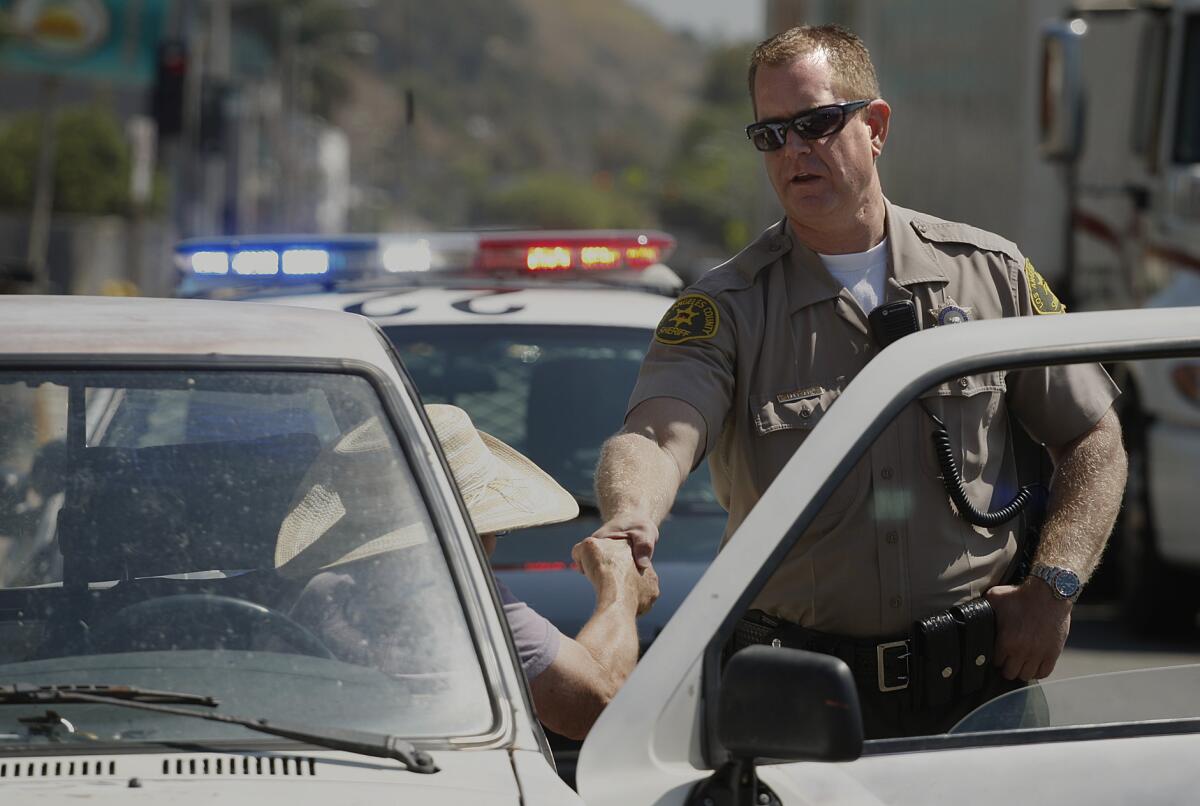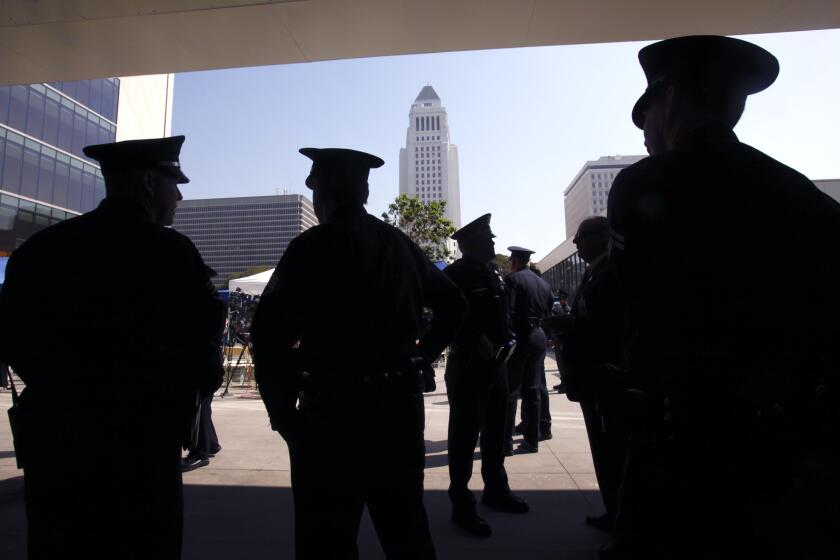L.A. County using cameras to combat wrongful jailings

Along with his Taser, baton and handgun, Los Angeles County sheriff’s Det. David Huelsen has a new tool for meting out justice: a point-and-shoot camera.
The Malibu traffic detective is among a handful of cops the Sheriff’s Department has equipped with digital cameras as part of an effort to reduce the number of innocent people jailed after being mistaken for wanted criminals.
The reforms come after a Times investigation detailed how authorities in the county had incarcerated people mistaken for wanted criminals more than 1,480 times over five years. Some spent weeks behind bars before the errors were realized. In recent months, other law enforcement agencies around the country have also been confronted with the problem, but the L.A. County Sheriff’s Department is emerging as one of the leaders in attempting to solve it.
FULL COVERAGE: Jails under scrutiny
Deputies are using the cameras to take photos of people who get cited but don’t have ID. If a defendant misses court appearances and becomes the subject of an arrest warrant, officials hope having the photos on file will avoid cases of mistaken identity.
“I don’t want to arrest someone for a crime they really didn’t do,” said Huelsen, a coordinator for the pilot program, while patrolling Pacific Coast Highway. “All the time you pull someone over, you run their name and it comes back with warrants and it’s like ‘Am I taking this guy in or not?’ ”
Sheriff’s officials expect to give cameras to additional deputies in the future and said that having more photographs attached to outstanding warrants will allow judges to quickly realize when innocent people have been picked up on warrants not meant for them. Under the new program, deputies will also be required to fill out a form that compares the newly detained person’s identifying features, such as the unique number assigned to a suspect’s fingerprints, side by side with those of the person listed on the warrant. A supervisor will have to review the form when the suspect is booked.
The Times found that many victims of this problem had the misfortune of sharing names with criminals who have outstanding warrants. Others had had their identities stolen by wanted criminals.
By the end of next year, sheriff’s officials said, they hope to provide deputies with devices that take the fingerprints of everyone cited and released in the field, a method of identification even more foolproof than photographs. They’re also considering requesting legislation that would revamp the state’s warrant database and wipe away warrants that are old and minor or meant for suspects who have since died.
“Everyone deserves to have this solved,” said sheriff’s Chief William McSweeney, who headed a task force that reviewed the problem. “Going to jail, if it’s not you, is obviously disturbing.”
Sheriff’s officials point out that the number of mistaken identifications has been declining and the cases make up just a tiny fraction of the population inside L.A. County lockups, the largest jail system in the nation. They said that many victims were wrongly detained after they were arrested on a separate charge and authorities mistakenly linked them to an outstanding warrant.
Nevertheless, for those wrongly jailed, the experience can be harrowing.
In one case reported by The Times, a mechanic held for nine days in 1989 on a warrant meant for someone else was detained again 20 years later on the same warrant. He was jailed for more than a month the second time before the error was discovered. In another case, a former construction worker mistaken for a wanted drug offender said he was assaulted by inmates and ignored by guards.
The problem is by no means exclusive to Los Angeles County. In recent months, at least two other cities have struggled with the issue. In St. Louis, the mayor launched a task force to stop the incarceration of misidentified people after a news report there detailed several such cases, including two in which the individuals were stuck in jail for months. And in Denver, civil rights attorneys sued authorities, claiming more than 500 people had been wrongly jailed there over seven years, with some even pleading guilty to crimes they didn’t commit before authorities realized their mistake. In one reported case, a black man was jailed for nine days on a sex crimes warrant meant for a white man.
Critics of the L.A. County Sheriff’s Department welcomed the reforms but said more could be done.
Attorney Donald W. Cook, who has represented more than a dozen people mistakenly held on warrants, called the changes “a step in the right direction.”
He said that for years the sheriff’s lawyers maintained there was nothing wrong with the system. Cook complained that officials acted only after The Times highlighted the problem in December.
“Then there was a fallout, and [Sheriff Lee] Baca comes out and does an about-face,” he said.
The Times found that the wrongful jailings occur because of breakdowns not just by sheriff’s officials but by police in other jurisdictions who arrest the wrong people, and by the courts, which have issued warrants that did not precisely identify the right suspects.
Cook agreed, saying judges should take a more active role in solving the problem. In California, people who are arrested are assigned a unique nine-digit number matched to their fingerprints. The courts, he said, should make sure that those numbers are always included on warrants.
Judge Patricia Schnegg, who supervises the county’s criminal courts, said there’s nothing more they can do because court clerks already ask for the numbers and include them on warrants whenever they’re available.
Through August of this year, sheriff’s officials reported 120 instances of wrongly jailed people, just four fewer than during the same period last year.
While the reforms address some of the reasons why people are mistakenly arrested on warrants, they do little to deal with criticism from victims who say they made repeated pleas that went ignored by deputies. The Sheriff’s Department has a stated policy to launch investigations when inmates protest that they’ve been misidentified, but records show that investigations were conducted for only a small fraction of the people who courts eventually ruled were not the right suspects.
McSweeney said jail deputies often overlook such complaints, adding that they are bombarded with inmates making false claims. The department, he said, decided instead to focus on trying to prevent the problem earlier in the process, before arrestees get to jail.
Phillip Reed, who was arrested in 2009 on a warrant meant for his brother, said he was pleased that the county was taking on the problem but believed the reforms came too late. He said his wrongful jailing caused him to fail background checks for two job opportunities.
“The damage is pretty much done for me,” he said.
FULL COVERAGE: Jails under scrutiny
More to Read
Sign up for Essential California
The most important California stories and recommendations in your inbox every morning.
You may occasionally receive promotional content from the Los Angeles Times.












